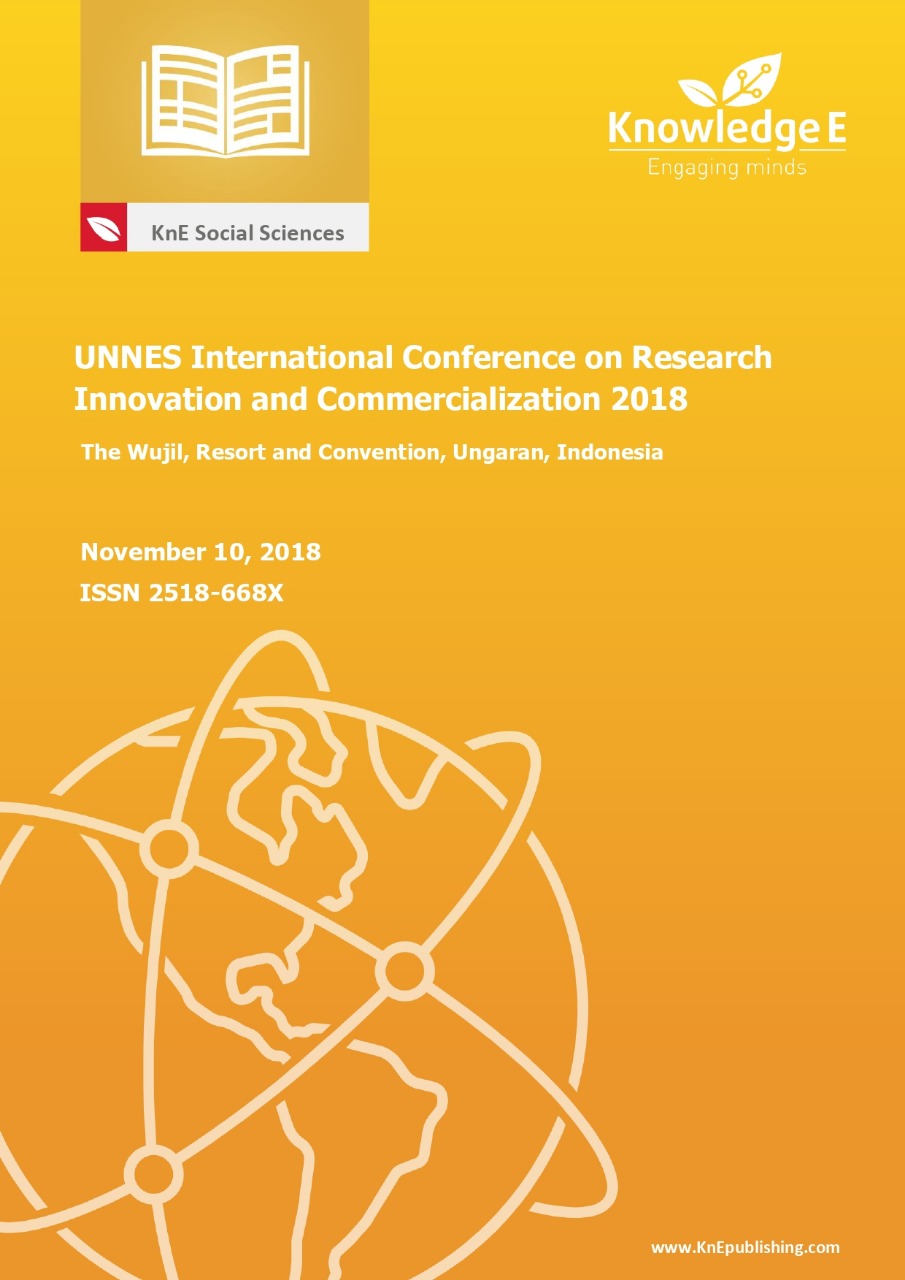The Effect of Motivation and Team Dynamic on Entrepreneurial Learning Success
DOI:
https://doi.org/10.18502/kss.v3i18.4758Abstract
The growth of the non-formal education sector in the last decade is indispensable as a form of social services provided by an organization to be a reference for marginalized people to be able to pursue education equivalent to formal education. Entrepreneurship-based learning is an important solution to help and supplement the non-formal education sector to successfully meet many of these challenges. One benefit that is seen in combining entrepreneurship learning systems into non-formal education is the development and improvement of the provided curriculum followed by the conversion of lessons learned into practices and operating principles that help individuals in the organization to maintain and improve their performance capabilities so as to produce graduates who are ready work. Non-formal education is seen as a sustainable resource for learning and improvement not only for individuals in the organizationbutalsoforpartnersandstakeholdersaffiliatedwithnon-formaleducation. Effective motivation and team dynamics are factors that influence learning to develop entrepreneurial capacities that are important for the innovation process taken on opportunities that help build and grow non-formal education. There are motivations and dynamics of effective program implementation teams, better strategies, policies, actions, decisions, resource allocations, and many more benefits that will all lead to theabilityofnon-formaleducationtogrowanddevelopandadaptefficientlytochange.
Keywords: entrepreneurship based learning, motivation, team dynamic
References
Atkinson, R. and Flint, J. (2001). Accessing hidden and hard-to-reach populations: snowball research strategies. Social Research Update, Vol. 33 No. 1, pp. 1-4.
Ashforth, B.E. and Saks, A.M. (2000). Personal control in organizations: a longitudinal investigation with newcomers. Human Relations, Vol. 53 No. 3, pp. 311-339.
Bloom, M. and Colbert, A.E. (2011). An integration and extension of intrinsic motivation theories: the role of core affect. Personnel and Human Resources Management, Vol. 30, pp. 73-114.
Buckley, M.R., Fedor, D.B., Veres, J.G., Wiese, D.S. and Carraher, S.M. (1998). Investigating newcomer expectations and job-related outcomes, Journal of Applied Psychology, Vol. 83 No. 3,pp. 452-461.
Castka, P., Sharp, J.M. and Bamber, C.J. (2003). Assessing teamwork development to improve organizational performance. Measuring Business Excellence, Vol. 7 No. 4, pp. 29-36.
Champoux, J.E. (1996). Organizational Behavior: Integrating Individuals, Groups, and Processes. West Publishing Company, St Paul, MN.
Dugoni, B.L. and Ilgen, D.R. (1981). Realistic job previews and the adjustment of new employees. Academy of Management Journal, Vol. 24 No. 3, pp. 579-591.
Galletta, M., Portoghese, I. and Battistelli, A. (2011). Intrinsic motivation, job autonomy and turnover intention in the Italian healthcare: the mediating role of affective commitment. Journal of Management Research, Vol. 3 No. 2, pp. 1-19.
Johnson, P.R., Heimann, V.L. and O’Neill, K. (2000). The wolf pack: team dynamics for the 21
Kuvaas, B. (2009). A test of hypotheses derived from self-determination theory among public sector employees. Employee Relations, Vol. 31 No. 1, pp. 39-56.
Kuvaas, B. and Dysvik, A. (2009). Perceived investment in employee development, intrinsic motivation and work performance. Human Resource Management Journal, Vol. 19 No. 3,pp. 217-236
Lawler, E.E. and Hall, D.T. (1970). Relationship of job characteristics to job involvement, satisfaction,and intrinsic motivation. Journal of Applied psychology, Vol. 54 No. 4, pp. 305-312
Leung, S.H.N., Chang, J.W.K. and Lee, W.B. (2003). The dynamic team role behavior: the approaches of investigation. Team Performance Management: An International Journal, Vol. 9 Nos 3/4, pp. 84-90.
Lumsden, G. and Lumsden, D. (2000). Communicating in Groups and Teams: Sharing Leadership,3rd ed., Wadsworth, Belmont, CA.
Major, D.A., Kozlowski, S.W., Chao, G.T. and Gardner, P.D. (1995). A longitudinal investigation of newcomer expectations, early socialization outcomes, and the moderating effects of role development factors. Journal of Applied Psychology, Vol. 80 No. 3, pp. 418-431
Meng, F., Zhang, J. and Huang, Z. (2014). Perceived organizational health as a mediator for job expectations: a multidimensional integrated model. Public Personnel Management, Vol. 43 No. 3, pp. 355-370.
Moustakas, C. (1994). Phenomenological Research Methods. SAGE Publications, London
Nelson, D.L. and Sutton, C.D. (1991). The relationship between newcomer expectations of job stressors and adjustment to the new job. Work and Stress: An International Journal of Work, Health and Organisations, Vol. 5 No. 3, pp. 241-251.
Osteraker, M.C. (1999). Measuring motivation in a learning organization. Journal of workplace Learning, Vol. 11 No. 2, pp. 73-7.
Patton, M.Q. (2002). Qualitative Research and Evaluation Methods,3rd ed. Sage Publications, Thousand Oaks, CA
Porter, L. and Steers, R. (1973). Organizational, work, and personal factors in employee turnover and absenteeism. Psychological Bulletin, Vol. 80 No. 2, pp. 151- 176
Porter, L.W., Bigley, G.A. and Steers, R.M. (2003). Motivation and Work Behavior, 7th ed., McGraw Hill, New York, NY.
Ryan, R.M. and Deci, E.L. (2000). Self-determination theory and the facilitation of intrinsic motivationsocial development, and well-being. American Psychologist, Vol. 55 No. 1, pp. 68-78.
Senge, P.M. (1997),The Fifth Discipline: The Art and Practice of the Learning Organization. Century Business, London
Turnley, W.H. and Feldman, D.C. (2000). Re-examining the effects of psychological contract violations:unmet expectations and job dissatisfaction as mediators. Journal of Organizational Behavior,Vol. 21 No. 1, pp. 25-42.
Wanous, J.P., Poland, T.D., Premack, S.L. and Davis, K.S. (1992). The effects of met expectations on newcomer attitudes and behaviors: a review and meta-analysis. Journal of Applied Psychology, Vol. 77 No. 3, pp. 288-297
Wexley, K.N. and Yukl, G.A. (1984). Organizational Behavior and Personnel Psychology, Richard D. Irwin, Homewood, IL
Zachary, W.B. and Kuzuhara, L.W. (2005). Organizational Behavior: Integrated Models and Applications, South-Western, Mason, OH
Zhang, X. and Bartol, K.M. (2010). Linking empowering leadership and employee creativity: the influence of psychological empowerment, intrinsic motivation, and creative process engagement. Academy of Management Journal, Vol. 53 No. 1, pp. 107-128

